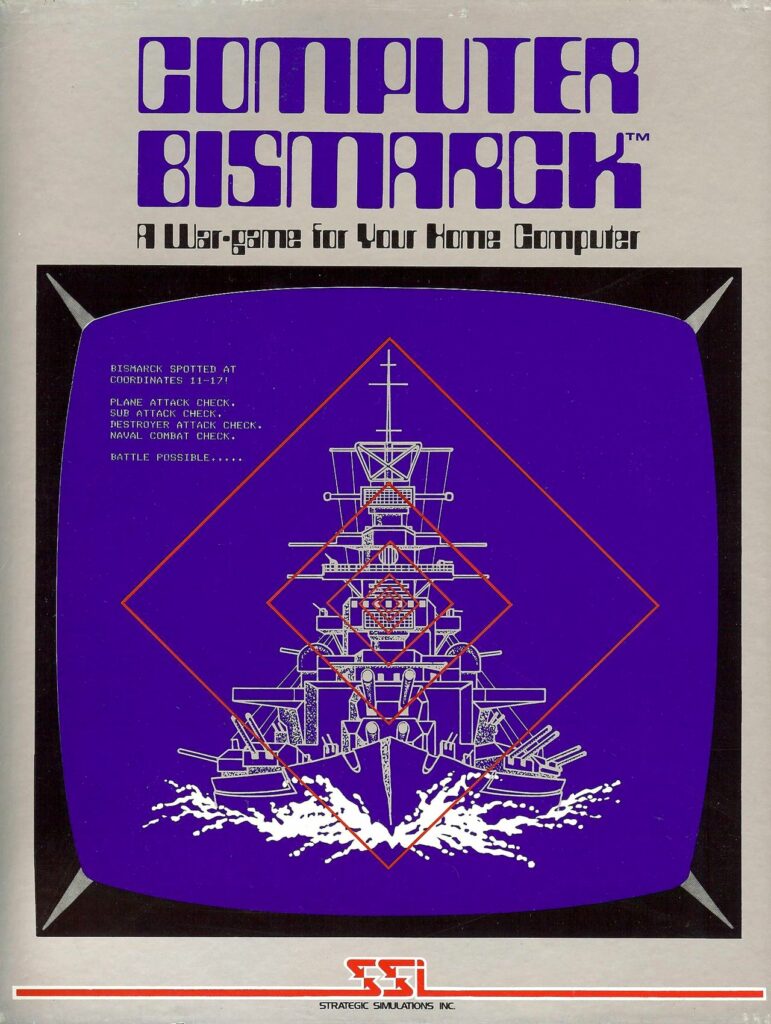
Computer Bismarck by John Lyon and Joel Billings, published by Strategic Simulations, USA
First release : January 1980 on Apple II,
Tested on : Apple II Emulator
Total Hours Tested : 8
Average duration of a battle : 1-5 hours
Difficulty: Average (2/5)
Would recommend to a modern player : No
Would recommend to a designer : Yes, for the search design
Final Rating: Quite good
Note that this review assumes you have read my AAR for Computer Bismarck.
This review was updated on 21/11/2021 to correct a mistake in the description of the content of the box and to update the ratings to the new system.
In my first rating and review on Tanktics, I described how some designers saw computers as future referees for wargames which would also take care of the tedious board maintenance operations. From the designer’s note attached to the manual, Computer Bismarck was indeed first designed and tested as a multiplayer game with the computer acting as the referee, with the AI only added at the end of the project.
I also mentioned the complexity of naval board games and the difficulty to represent without a neutral third party the “search” for the enemy ships. It is therefore not surprising that many of the first computer wargames (Computer Bismarck, Midway Campaign, North Atlantic Convoy Raider) were about sea operations.
Computer Bismarck seems to have been an unofficial rip-off of an Avalon Hill 1978 board game, with some minor modifications (battles were simplified and obviously the British player does not have to signal where his fleet is by announcing to the German player that he is searching in this or that area). This is especially ironic, as Avalon Hill and Strategic Simulations Inc. (better known as SSI) would be the two competitors on the computer wargame segment for in the beginning of the 80s.
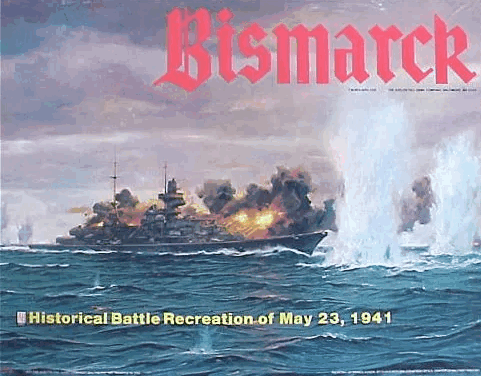
As opposed to the choice made by Chris Crawford in Tanktics, the rules of the game and the calculation are explained at length in the Computer Bismarck manual, though in spite of the effort some rules are confusing and would have created a lot of issues if they had not been referred by a computer.
The packaging of the game was of extremely high quality : the box included a map and two grease pencils so the player can more easily follow the movement of their ships than on the limited computer interface, there were several reference cards including the keyboard commands and the stats of each ship, in addition to the manual which included a well-written four-page history of the Bismarck. Of course, this had a price : 60 USD (which apparently would be the equivalent in 2021 of 210 USD) ; since the game initially was only released on a $2100 Apple II it became “the 2160$ Wargame”.
So, how does the modern gamer that I am rate Computer Bismarck :
A. Settings & Aesthetics
In terms of settings, Computer Bismarck looks perfect when you start playing. Every ship that matters is represented, capital ships are all different from one another, and even the cruisers have different stats depending on their age. The ruleset reinforces this realism, and everything that happened during the real chase could happen in the game : the German ships can, rarely, break radio silence and signal their position, ships can lose fuel from an unlucky hit, …

This feeling of realism collapses during ship-to-ship combat, which feels extremely streamlined. All warships are given a simplified “firepower” value, and even the oldest cruiser can damage the Bismarck.
As for sounds & graphics – no such thing in this game apart from the shape of the landmass.
Score : Poor
B. UI , Clarity of rules and outcomes
The game has one of the worst UI I have ever seen. The problem is not the fact that all commands are through keyboard – this was the norm back then – but the way your orders are displayed on your screen. When you tell a ship or a plane to move, it moves its graphical representation (a letter) to a new location, leaving the previous location empty, even if it had other planes or ships. This means that you have no visual feedback anymore about where your forces are, until you leave the “order” menu and ask the game to redraw your units.
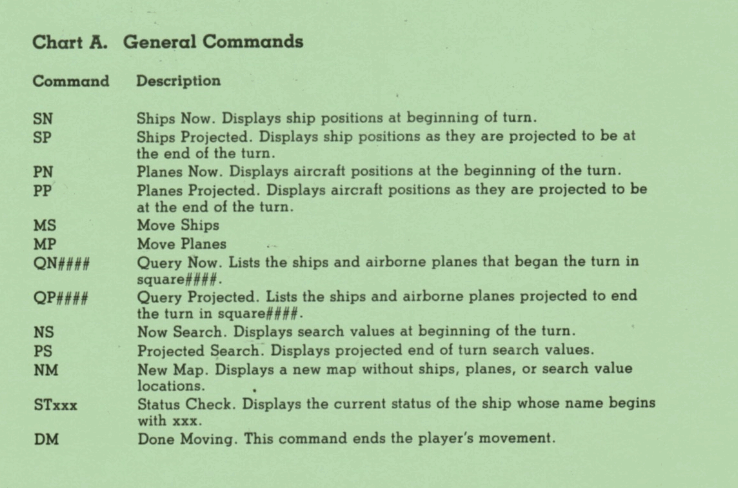
In addition, the game decided that the convoys would not use the [M]ovement command but rather the [F]ast Convoy or [C]onvoy command, even though they all do exactly the same thing. I assume it comes from the fact that convoys don’t move every turn but it should have been transparent for the player.

The only positive thing I have to say about the UI is that the reference cards are well-done, and using them beats checking in-game stats for the ships through keyboard commands. A player who would have bought the box in the 80s could have also used, like in Tanktics, counters and a board. Unlike Tanktics though, this probably was legacy and the game as we have seen was fully playable without them.
While the search rules are perfectly clear, the outcomes of encounters are hard to decipher, in particular I still have not understood what happens on the strategic map when a ship withdraws from combat – does she move to another tile or stay where she was ? Results seemed inconsistent, which is a problem for such a fundamental part of the game.
There are other less important issues, eg:
- the game does not tell you what time of the day it is, except during transition between turns,
- there is no feedback on the effect of hitting the enemy ships (one should not know the extent of all the damage caused, but the player should be informed if the Bismarck seems to have slowed down for instance),
- there are items in the manual that do not seem to be in the game (the manual states that searching Bergen when the fog has lifted triggers the activation of the response force, as it shows that the Bismarck has left port – I could never trigger this),
- I never managed to engage a submarine, even with bombers ; the manual is silent on how to fight them.
Overall, the game has a glaring weakness here.
Score : Terrible
C. Systems
UI aside, the “high-level” system (the search) is solid – it is thematic and it works well. The player will plan, the plans will fail, there will be back-up plans, there will be execution issues as the weather does not play its part. The player will despair as night approaches, as planes run out of fuel, as the storm refuses to abate. The player will bite their nails, hoping every turn to catch the Bismarck in their net, they will make hypotheses, arbitrage between separating their force or concentrating in key-areas, until finally the Bismarck is seen.
I did not cover it too much in my AAR, but the player will also have to decide between moving their ships as fast as possible between areas of interest – but burning the limited fuel – or moving more slowly. The player will have to decide whether sending as many planes as possible as soon as available, or maintain a lower but more consistent level of search.
On the other end, the “low-level” system (the combat) is extremely simplified, and not satisfying at all. Once the Bismarck is found, there is no gameplay grand finale, and the game is very likely to be over in a couple of turns. The game is about the search, the combat is just a simplified way to calculate if enough ships found the Bismarck to sink it. Worse, a fast cruiser may be enough to stop the Bismarck from withdrawing, which then means that the entire English battleline – even the slowest ships – gets to shoot at it ; it generates some very unrealistic outcomes.
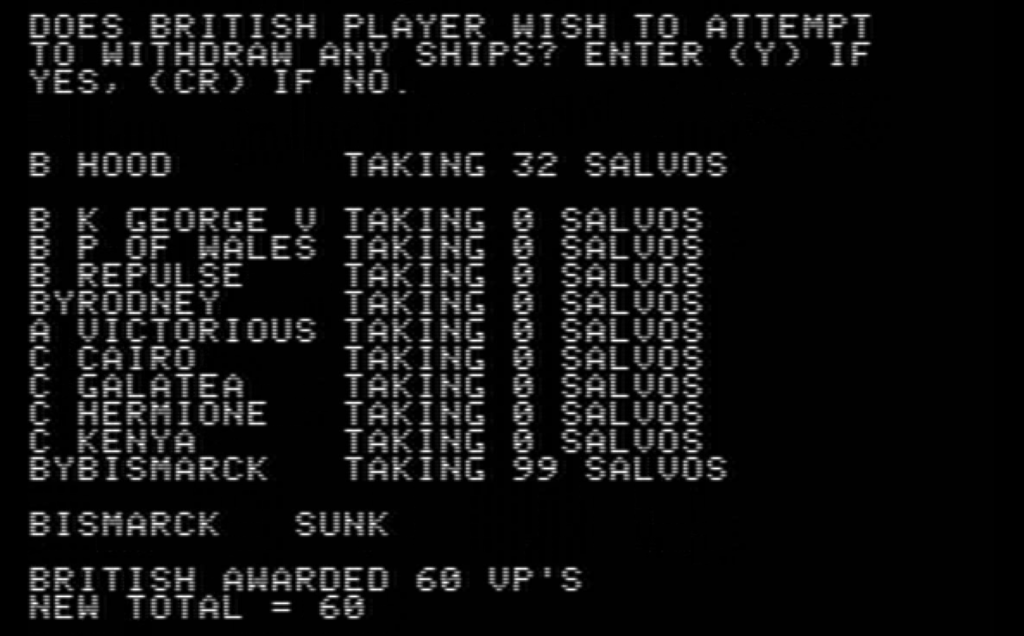
…wait, you need to give orders to your convoys for 10 more turns before the game actually ends.
There are a few frustrating rules : the player is forced to move between 2 and 7 convoys every other turn, which is pretty uninteresting and could maybe have been left to the AI. In addition, the game carries on after the Bismarck and Prinz Eugen are sunk if the point gap between the two players is small, and the only thing left to do for the British player is to move the convoys and pray that the German submarines don’t find them.
Score : Good
D. Scenario design & Balancing
There is only one scenario, but it is designed with love.
As well-designed as it is, offering a “randomized” opening in addition to the historical one would have been appreciated, though to be fair the very different weather patterns can really alter the chase.
The game feels well balanced overall, which is a feat for such an asymmetric game. The German forces have several possible strategies, and the safest (waiting for the night or for “perfect” weather, maybe going through the North of Iceland) will give them less time to chase the convoys once they reach the Atlantic.
In my case, I was convinced for a long time that the Prinz Eugen and maybe both ships had passed through, and indeed they could have if the AI had been more aggressive. If they had, they would have wrecked my convoys and I would have lost fair & square. But the AI did not, and I believe stuck to a predetermined plan.
As far as I understand, the game uses a seed at the beginning of the game to determine what will be the weather for the whole game, and the AI strategy is based on that weather (possibly, the early moves are hard-coded for each seed).
Score : Excellent
E. Fun and Replayability
I had fun playing this game, but I will not replay it, at least in single player.
As fun as the game is, it is also incredibly slow. Due to the terrible UI, giving orders each turn takes 10 to 15 minutes, and then even on my fast modern computer the resolution takes several minutes. Given there is only one scenario, the opening is going to be mostly the same. I also dread having to move the convoys again in my future games.
Computer Bismarck is only really fun if the Bismarck is detected at just the right time : neither too early (in which case no chase and a quick German game-over) nor too late (which would make a very, very long game before anything exciting happens.)
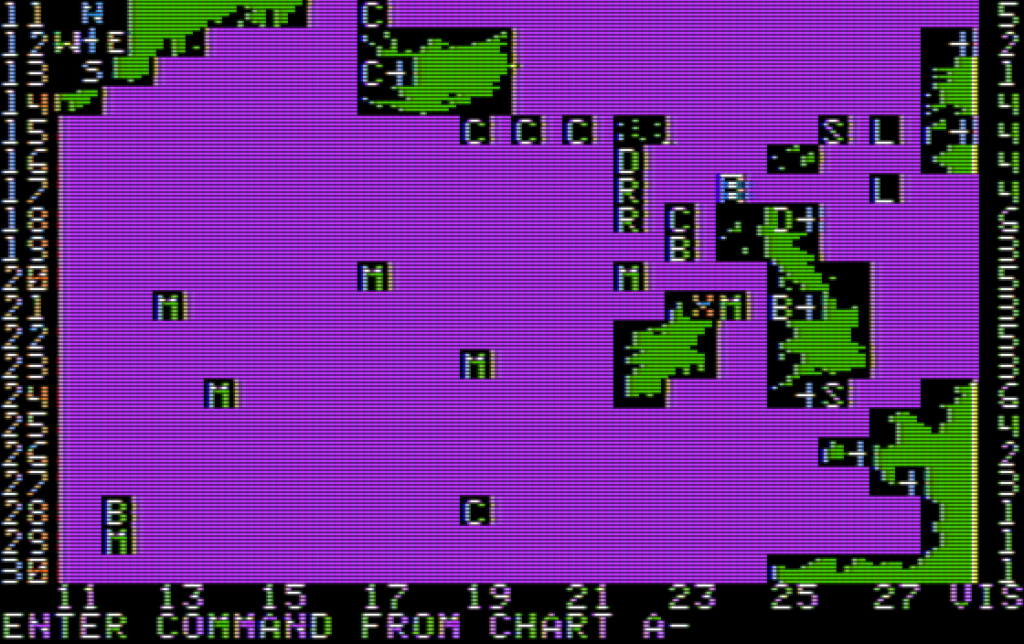
Score : Very poor
F. Final rating
Quite good !
Computer Bismarck has a very solid design on the strategic level and an engaging scenario, but most of the player’s time will be spent fighting against the UI, and the ending (when the Bismarck is found) tends to be particularly anti-climatic.
Contemporary reviews
Computer Bismarck did not age well, but the admittedly few reviews at release were overall enthusiastic. It was seen as the first port of a wargame on a computer, more so than Tanktics.
The game even had coverage outside of computer-specialized magazines, for instance in the Popular Mechanics issue of August 1980 (“Only real war rooms (…) have ever been able to simulate a battle in this manner”) !
The only recurring complain about the game was its slowness – apparently on TRS-80 it could take several hours for the computer to calculate the outcome of a turn, whereas for Apple II it seemed more manageable at roughly up to 20 minutes a turn. Byte, in a review published in December 1980, said “Movement of pieces in this game, which must be done one piece at a time, is time-consuming and tedious”. The reviews regrets – just like I do – that ships and in particular the convoy cannot be ordered to steam toward coordinates and instead have to be given a new order every turn, which is seen as another legacy of tabletop. The article was still very positive, calling the AI a skillful opponent.
As for France, the only reference I could find on this game is in Tilt‘s March 1984 retrospective on wargame : the description of the game is short and the game is rated 3/6.
Computer Bismarck was for sure innovative ; its commercial tagline was “you have never played something like this”. But its terrible UI ensured it would age like milk. And indeed, in 1991, the Computer Gaming World retrospective is ruthless :“The game that started SSI, its age and functional obsolescence make this product useful only to the collector. More of a computer assist to a boardgame than a true computer game“. Possibly out of respect for the ancestor of the genre, CGW did not include a rating with this murderous description.
SSI’s next moves
Computer Bismarck was the first of six games SSI released in 1980. More expensive than most if not all games on the market, it was an unexpected success. It appears to have sold 8 000 copies though it is not clear over which period of time. In any case Computer Bismarck and the other 1980 games would position SSI very strongly on the wargaming niche. As we have seen, Avalon Hill, the leader on tabletop wargame, would also try to enter the computer market with a string of cheap games released together in Summer 1980 ; but those games were very limited and in the following years the giant Avalon Hill will be the challenger against the leader SSI.
If you are interested, the digital antiquarian has done an excellent history of the early days of SSI, which I warmly recommend. You can also check the Data Driven Gamer review for Computer Bismarck here